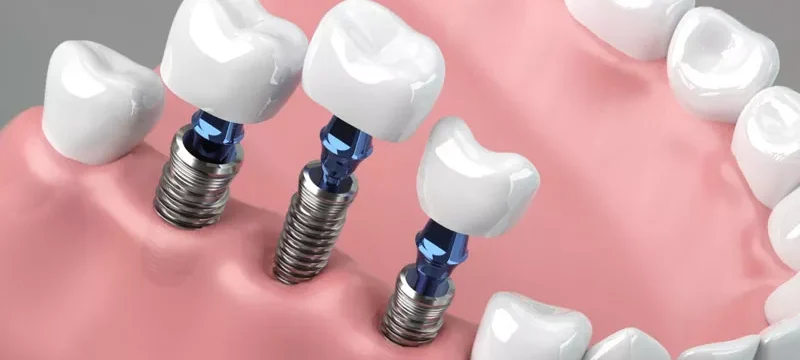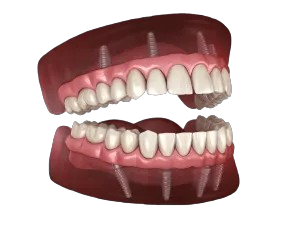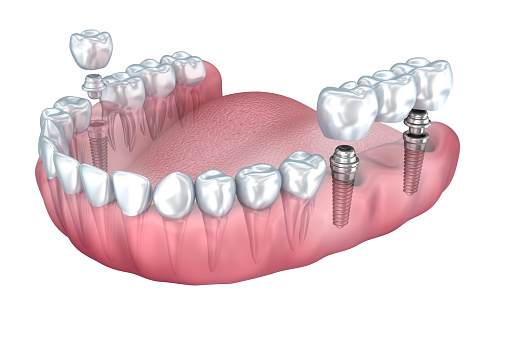
Dental implants have revolutionized the field of dentistry, offering a reliable and aesthetically pleasing solution for individuals missing one or more teeth. Many people wonder if dental implants can effectively replace multiple teeth. This blog will explore the various methods available for replacing multiple teeth with dental implants, their benefits, and what to expect during the procedure.
Understanding Dental Implants
Dental implants are titanium posts surgically inserted into the jawbone, serving as artificial tooth roots. Once integrated with the bone, they provide a stable foundation for crowns, bridges, or dentures. This method not only restores functionality but also helps maintain jawbone integrity, preventing the bone loss that often accompanies missing teeth.
Options for Replacing Multiple Teeth
When it comes to replacing multiple teeth, there are several options available:
1. Implant-Supported Bridges
An implant-supported bridge is an effective solution for replacing several adjacent missing teeth. In this case, two or more dental implants are strategically placed in the jawbone to support a bridge that holds multiple artificial teeth. This option is particularly beneficial for those who have lost several teeth in a row, as it provides enhanced stability compared to traditional bridges that rely on adjacent natural teeth.
2. All-on-4 Implants
For patients who have lost an entire arch of teeth (upper or lower), the All-on-4 implant technique offers a comprehensive solution. This method involves placing four implants in strategic locations within the jawbone to support a full set of prosthetic teeth. The All-on-4 technique allows for immediate placement of a temporary denture on the same day as surgery, providing patients with a functional smile almost instantly.
3. Partial Dentures Supported by Implants
Another option is to use dental implants to support partial dentures. In this scenario, implants are placed at specific points in the jaw to anchor removable dentures securely. This enhances comfort and stability while eating and speaking, making it easier for patients to adapt to their new dental appliances.
Benefits of Dental Implants for Multiple Teeth
Choosing dental implants to replace multiple missing teeth comes with numerous advantages:
- Natural Appearance and Functionality: Dental implants closely mimic the look and feel of natural teeth. Patients can eat, speak, and smile confidently without worrying about their dental prosthetics moving or slipping.
- Bone Preservation: One of the significant benefits of dental implants is their ability to preserve jawbone density. When teeth are lost, the underlying bone can deteriorate over time due to lack of stimulation. Implants provide the necessary stimulation to maintain bone health.
- Durability and Longevity: With proper care and maintenance, dental implants can last a lifetime. They are highly durable and resistant to decay, making them a long-term investment in oral health.
- Improved Oral Health: Unlike traditional bridges that require alteration of adjacent healthy teeth, dental implants do not compromise surrounding teeth. This helps maintain overall oral health and integrity.
The Procedure for Getting Dental Implants
The process of receiving dental implants typically involves several steps:
- Consultation and Examination: The first step is an in-depth consultation with your dentist or oral surgeon. They will assess your oral health through examinations and imaging tests like X-rays or CT scans.
- Treatment Planning: Based on your specific needs and bone structure, a personalized treatment plan will be developed. If necessary, procedures like bone grafting may be performed prior to implant placement.
- Implant Placement: During the surgical procedure, titanium implants are inserted into the jawbone under local anesthesia or sedation. The healing period usually lasts several months as the implants fuse with the bone, a process known as osseointegration.
- Abutment Placement: Once healing is complete, abutments (small connectors) are attached to the implants. These will hold the final restorations in place.
- Final Restoration: After additional healing time, custom-made crowns or bridges are placed on the abutments, completing the restoration process.
Caring for Your Dental Implants
After receiving dental implants, proper care is essential for their longevity:
- Maintain Good Oral Hygiene: Brush twice daily and floss regularly around your implants to prevent plaque buildup and gum disease.
- Regular Dental Checkups: Schedule routine visits with your dentist for professional cleanings and examinations to ensure your implants remain healthy.
- Avoid Harmful Habits: Refrain from smoking and limit alcohol consumption as these can negatively impact healing and implant success.
If you experience any complications or discomfort after getting your dental implants, it’s crucial to consult with Dental Implants in Rockville MD immediately for prompt care.
Conclusion
Dental implants offer an effective solution for replacing multiple missing teeth, providing patients with restored functionality and aesthetics. With various options available—such as implant-supported bridges and All-on-4 techniques individuals can choose a method that best suits their needs and lifestyle. By understanding the benefits and procedures involved in getting dental implants, patients can make informed decisions about their oral health that lead to lasting smiles and improved quality of life.


